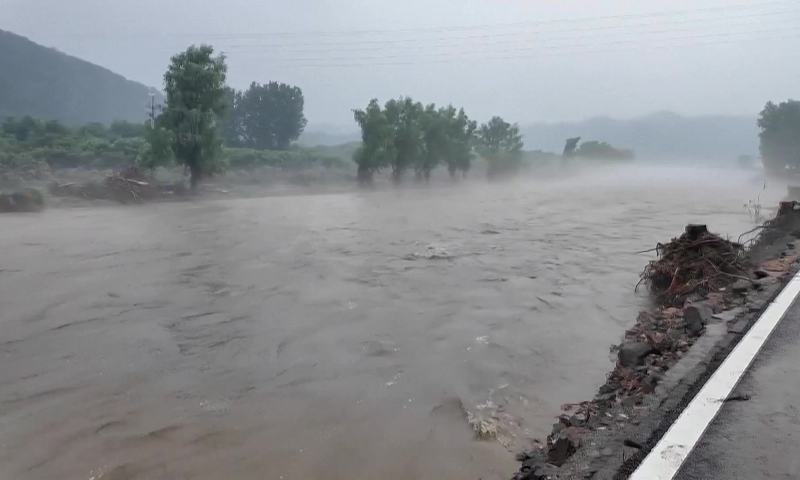Beijing declares highest flood alert; central government earmarks 50 million yuan for Hebei disaster relief

Multiple regions in North China including Beijing and Hebei Province have been lashed by torrential rains and flood.
Beijing issued a flood red alert on Monday, warning mountainous areas in its districts such as Yanqing, Huairou and Miyun faced extremely high risks of slope collapses and rockfalls from Monday morning to Tuesday morning, according to the municipal authorities.
Meanwhile, the National Development and Reform Commission has activated a Level IV national disaster relief emergency response on Monday, urgently allocated 50 million yuan ($6.97 million) from the central budget to support emergency recovery efforts in Hebei Province following the devastating rainstorms and floods, People's Daily reported Monday.
Beijing has suspended all organized outdoor sports activities as the capital city earlier issued a yellow flood warning and upgraded an orange rainstorm warning on Monday morning amid heavy rains, according to multiple media outlets on Monday.
Beijing Emergency Management Bureau said on Monday that it is expected that the water level at the cross-section of the Chaobai River Basin will reach the yellow warning level starting from 8:00 am. Residents are advised to stay away from the river to ensure their safety.
Beijing Emergency Management Bureau announced that it is expected that from now to 10 am on Tuesday, most areas of the city will be lashed by heavy rains. Among them, the cumulative rainfall in some areas of Miyun, Pinggu, Huairou, Shunyi, Fangshan, Mentougou, Yanqing, Changping, Haidian and other areas can reach more than 100 mm in 6 hours, and some points can reach more than 250 mm. At mountainous areas and shallow mountainous areas, at present, the risk of flash floods, mudslides, landslides and other disasters is extremely high, and stagnant water may occur in low-lying areas.
Persistent rainfall from Saturday to Sunday in China has caused floods exceeding warning levels in 31 rivers across Hebei, Beijing, Inner Mongolia, Shanxi, Shaanxi, Yunnan, and Xinjiang, with water levels 0.05 to 3.48 meters above alert thresholds, China News Service reported Monday.
The latest round of precipitation has been concentrated in the Haihe River Basin. As of 4:00 pm on Sunday, 10 rivers, including the Chaohe and Baihe rivers (the two headwaters of the Chaobai River) and the Nanyang River (a tributary of the Yongding River's upper reaches), experienced their highest recorded flood levels since measurements began, the report said. The Haihe River, northern China's main water system, drains the Beijing-Tianjin-Hebei region before emptying into the Bohai Sea.
According to the municipal sports authority on Sunday evening, as the Beijing meteorological observatory issued a yellow rainstorm warning on Sunday, forecasting that from Sunday afternoon to Monday morning, most areas of Beijing would experience hourly rainfall exceeding 30 millimeters, with localized accumulations potentially surpassing 100 millimeters. The warning indicated that mountainous and semi-mountainous areas might face secondary hazards including flash floods, mudslides and landslides. Simultaneously, districts including Yanqing, Huairou and Miyun were placed under red alert due to extremely high risks of geological disasters.
Considering above situation, all organized outdoor sporting events and outdoor sports training sessions shall be suspended immediately. Also, emergency alert protocols must be activated for participants of organized mountaineering expeditions, adventure activities, hiking/trekking programs, cycling events and water sports activities, said Beijing sports authority.
Multiple other regions in China also have been lashed by torrential rainfall. China launched a national disaster relief emergency response on Monday and guided North China's Hebei Province in effectively managing rainstorm and flood disaster relief efforts.
Affected by recent heavy rainfall, the Luanhe River in the Haihe River Basin has experienced its first officially designated flood of 2025, marking the initial numbered flood event this year among China's major river systems, Guangming Daily reported Monday.
On Monday morning, the inflow rate at Panjiakou Reservoir (Tangshan, Hebei) on the main stream of the Luanhe River reached 2,270 cubic meters per second.
The reservoir is expected to face a peak inflow of approximately 4,000 cubic meters per second by the evening of July 28.